-
Posts
3,373 -
Joined
-
Last visited
-
Days Won
26
Content Type
Profiles
Forums
Events
Gallery
Blogs
Posts posted by Bigj66
-
-
Personnally I prefer a more Matt finish to a Series Landrover for no other reason than I just think it looks better.
-
15 minutes ago, lo-fi said:
Why not have a 5mm spacer made up to pick up the boss on the flywheel and locate on the crank without modification?
I did initially think of ‘filling in’ the recess in the back of the flywheel with a spacer to make it flush with the crank face but realised that the raised spigot boss is needed to sit in the crank and locate the flywheel. In addition to the central spigot boss the recess on the back of the flywheel also needs to sit over the end of the crank for the same reason.
If you were thinking about a ‘top hat’ style spacer I’m not sure how that would work with the crank hole being 18mm diameter and the flywheel boss 35mm diameter. Wouldn’t the thickness of the material required to make the boss push the flywheel further from the engine than the 5mm I need or have I misunderstood what you were referring to?
-
Turns out the 2.25 petrol flywheel is the same thickness as the 2.6 so I’d still be left with it further towards the engine than it would usually be. Could this have an effect on clutch operation?
-
I very much doubt the original factory tolerance was anywhere near 0.1mm 😐
You’ve done a good job there and should have confidence that with a decent gasket the engine will run fine. Good luck with the rest of the rebuild.
-
I’ve decided not to remove that raised area on the flywheel as it helps to centre the flywheel correctly on the crank. What I need to do is have the crank centre hole opened up to accept the boss on the flywheel instead.
I just need the 2.25 flywheel to be about 5mm thicker than the 2.6 one now. 2.6 is 35mm.
-
42 minutes ago, secondjeremy said:
The 2.6 S3 6 cylinder I worked on the other day seemed to have a full set of timing marks including the EP mark on the front pulley/damper.
Otherwise you'll have to compare the available marks on the 4 cylinder flywheel with what's required for the 6, assuming it fits in such a position that the marks are true.
With regard to the spiggot the issue will be does it prevent the nose of the first motion shaft from goung far enough forward towards the crank when fitted. Some measuring may solve your problem.
Thanks for the info 👍.
Thinking this through a bit more, if I trim the raised part of the spigot bush off the flywheel centre then in effect I will be moving the flywheel 5mm away from the gearbox and so the FMS, being attached to the gearbox, will remain in its position but will sit 5mm rearwards of the flywheel and the clutch will sit 5mm further away from the box on its splines.
The position of the FMS is fixed by the bell housing and the flywheel housing depths which are standard sizes so the question now is, will moving the flywheel and clutch plate 5mm away from the gearbox have any detrimental effect?
One other thing that may affect the outcome would be if there is any difference in the depth of the 4&6 cylinder bellhousings or the thickness of the 4 cylinder petrol flywheel compared to the 6 cylinder one as that could increase, decrease or have no effect at all on the position of the FMS.
Only other option would be to open up the hole in the crank to accept the boss on the flywheel but the outcome would be the same.
I could really do with a big pile of parts to mix and match and experiment with 😐
-
52 minutes ago, Chicken Drumstick said:
You may want to consider relocating the belt. You want it to pull the occupant ‘back’ into the seat, not ‘down’. Your arrangement would effectively try and crush the occupant and probably brake a collar bone.
Quite right, and as I’ll most likely go with a purpose made bar for the shoulder anchor point from the likes of Exmoor Trim etc then I should be able to achieve this.
Makes me laugh though when you see those old Landrover archive films with vehicles off-roading up hill and down dale with no roof or windscreen on and packed to the gunnels with people front and back hanging on for dear life 😊
-
-
2 hours ago, Bigj66 said:
Scrub that, I’ve realised that I need to have a matched set of flywheel housing and bell housing due to differences in the starter position. 😞
Edit: Just found out that the petrol flywheel is the same diameter as the 2.6 but with the 8 bolt pattern which is good news as it means I should be able to use the 2.6 housing, starter etc. And the 2.25 petrol clutch.
Only thing I can see is that the spigot bearing hole is proud of the face of the flywheel by 5mm.
The total depth of the spigot bush is 20mm so would it be okay to have both the bush and the flywheel machined so that the 5mm is removed and the flywheel will sit flush with the crank? Is the end of the input shaft that sits in the spigot the same length as the bush itself and if so would I also need to trim 5mm off that or is it the case that the input shaft is longer than the bush and needs to fit in the crank hole?
As always, any info appreciated.
Sorry, one further question about fitting a 4 cylinder flywheel to a 6 cylinder engine....timing marks, will I be unable to use the timing marks on the four cylinder flywheel and if so will I just revert to using the crank pulley to set things like TDC or to time the engine?
-
3 hours ago, Bigj66 said:
I’m wondering if the four cylinder bellhousing is larger than the six cylinder and if so would it fit to the original Rover flywheel housing?
Scrub that, I’ve realised that I need to have a matched set of flywheel housing and bell housing due to differences in the starter position. 😞
Edit: Just found out that the petrol flywheel is the same diameter as the 2.6 but with the 8 bolt pattern which is good news as it means I should be able to use the 2.6 housing, starter etc. And the 2.25 petrol clutch.
Only thing I can see is that the spigot bearing hole is proud of the face of the flywheel by 5mm. Looking at photos of the 2.25 petrol flywheel, it seems to have a similar raised area.
The total depth of the spigot bush is 20mm so would it be okay to have both the bush and the flywheel machined so that the 5mm is removed and the flywheel will sit flush with the crank? Is the end of the input shaft that sits in the spigot the same length as the bush itself and if so would I also need to trim 5mm off that or is it the case that the input shaft is longer than the bush and needs to fit in the crank hole?
As always, any info appreciated.
-
Presumably with that arrangement you’d need to swap the shoulder mounting over from the truck cab bracket to the roll bar fitting? Not too onerous I suppose.
-
I’m wondering if the four cylinder bellhousing is larger than the six cylinder and if so would it fit to the original Rover flywheel housing?
-
What a drama this is turning into!
Diesel flywheel arrived this morning so straight out to the workshop to compare it with the 6 cylinder flywheel and 3.0 engine.
Diesel flywheel is larger and thicker and also has a protruding central boss which holds the spigot bush.
Had to remove one of the two dowels off the end of the crank just to do a trial fit.
Offered it up to the crank but the protruding boss meant that I couldn’t get it to sit flush against the crank and I also noticed that the remaining dowel position on the crank was slightly different to the diesel flywheel hole. Using the flywheel spacer I was able to see how much it was out but more importantly, that the bolt hole spacing was correct.
You can just see the slight overlap between the spacer and flywheel dowel holes.
With the 2.6 flywheel housing fitted the diesel flywheel will not fit but with the Rover flywheel housing fitted the diesel flywheel fits okay. I’m not sure if the petrol flywheel is the same diameter as the diesel one and closer to that of the 6 pot LR but don’t have one to hand to check. I’m also not sure yet to what extent the petrol flywheel has a central boss as the diesel one does or what the impact of machining the boss down flush with the face would have on the functionality of the spigot bush itself?
It seems that I just need to experiment with different flywheel and flywheel housing combinations to arrive at the solution although it might end up that there is no solution. One possibility if I need it would be to reposition the bellhousing studs to match up to a suitable gearbox but there’s still some investigating to be done before get to that stage.
-
I’ve been searching around but can’t find an answer to this one (maybe because there isn’t one).
If I have a truck cab fitted that I want to remove during summer, what front seat belt anchor points can I use for the shoulder bracket? All the seatbelt bars look like they are designed for a soft top to be fitted but would interfere with a truck cab running across the top of the tub bulkhead. Do people fabricate their own bars/brackets to provide an anchor point with clearance for the cab to be refitted?
I should add that I have a pair of high back front seats fitted.
-
Can you get composite gaskets for the 4 pots as you can for the V8? Might be slightly more forgiving of slight surface variations once you’ve given the block a clean although I’ve seen worse than what’s in your photos before. These old engines are quite resilient.
-
Could you find a small bar magnet and stick it to the valve stem to stop it dropping?
-
I posted in this thread on this subject from Heystee.
-
-
If it’s both rear brake drums then I’m suspecting the master cylinder. Have you changed it?
-
I asked Heystee what master cylinder I should use with their front disc brakes and 8” servo and their reply was:
“You can use either the NRC9529 (Defender 90) or the NRC8690 (Defender 110). It is wise to mount an proportional valve between the master cylinder and the rear drums to balance the pressure between front and rear brakes.”
I suppose it depends on the performance of the engine you have - as already stated. I’ll go with front discs and rear drums with my 130hp engine. I know there are drum brake upgrades but the simplicity of disc brake maintenance sells it for me.
-
11 minutes ago, Gazzar said:
The diesel fly wheel may suit better than the petrol, as it should be a lot heavier.
The extra weight gives it more momentum, and thus should reduce any lumpiness from the engine. Mind you, I always thought 6 pots were sweeter. I've had a couple, a Jag and a Datsun and they were smooth.
The heavier wheel reduces the pickup of the engine, but reduces the risk of stalling in compensation.
Interesting point and as the original Rover flywheel was bigger to start with, things may just balance themselves out.
-
1 hour ago, lo-fi said:
Just build a nicely webbed piece to pick up the existing holes on the block and extend back to the mounts on the chassis. 6mm plate with strengthening webs will do the job. Drilling new holes in the block isn't likely to end well where there isn't extra meat cast in for bosses.
One other thought.... If the oil filter arrangement is the same as the 2.6, will that not foul the left hand mount in that position?
Also, before you get making anything, are you 100% sure you've got enough room to move it forwards that much without causing a major radiator headache, and you're definitely happy there's room to work on various maintenance chores once it's in?
Fingers crossed for the flywheel by the way.
Ample clearance between the LHS engine mount and the oil filter. The idea was to drill and tap the 12mm plate not the block 😳 I can always tack weld a nut on to the rear of the plate so no big dramas there.
As for the radiator, although the measurements I took at the beginning suggest that it will be tight but doable, the only way I’m really going to know is when I get the engine bolted up to the box and refit the radiator panel. If needs be I can trim the rad panel to move the rad forward an inch or so but my aim is to not have to do that.
My gearbox and transfer box could do with a rebuild anyway so at the same time I’ll get the 6 pot bell housing fitted to it and do a trial run before I even contemplate getting the engine rebuilt.
Workshop is nearly finished now so hopefully I can make a start on the project in the next month or so although I also need to learn how to weld.....
-
9 minutes ago, lo-fi said:
Nige, is that you???

Joking aside, that's probably overkill, but no harm it being beefy. I'd say it's a solid plan, it's basically what I've done at the gearbox end of my conversion, and the engine too somewhat. I didn't want to chop my chassis.
I had some thoughts about drilling and tapping two new holes to take the repositioned mount but I’m not even sure if a thread depth of 12mm would suffice or would it be best to use a nut and bolt?
-
I’ve picked up a diesel flywheel for a couple of quid this morning off EBay so will give it a try when it gets here. The seller emailed me the dimensions and bolt PCD which match those of the 2.6 flywheel and the Rover crank. The petrol and diesel flywheels have a different part number in the manual which may explain the difference in size you mentioned. Worst case is that I need a petrol one.
Looking at the engine mounts again I took some measurements of the position of the chassis mount bolt centre on my 4 pot and those on the rover engine. They are exactly 150mm apart. I’ve marked the position of the 4 cylinder mounting centre with the stick in the photo.
Question is would extending the engine mounts rearwards by 150mm cause any issues like vibration? I’m thinking that an adapter plate made out of 12mm steel with reinforcing ribs could be bolted to the block in place of the existing mount and then the mount either welded to the plate or bolted to it.



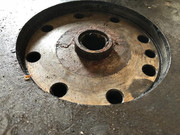
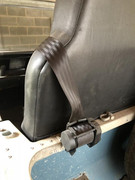
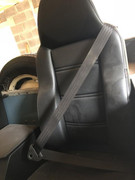
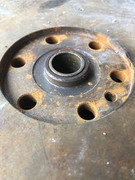
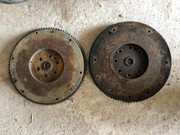
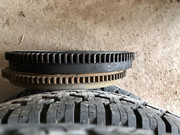
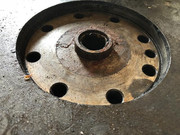
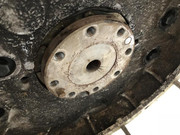
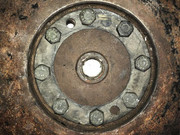
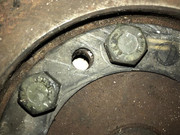
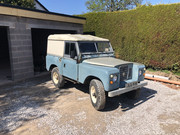
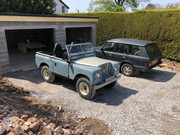

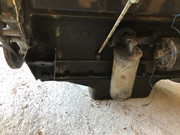
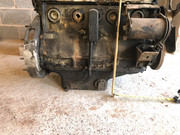
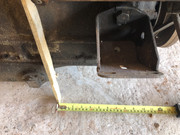
2.25 Petrol vacuum
in Series Forum
Posted
Craddocks etc still sell the fittings to use the servo port in the head.